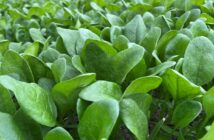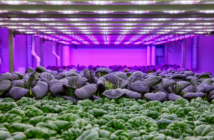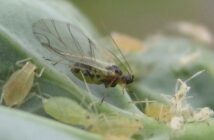The more oilseed rape in the ground, the more Light Leaf spot is found in brassicas such as Brussels sprouts. Not only has this disease increased massively in Brussels sprouts in Scotland and the North of England, but it is also found in overwintered cabbage in the South and East of Scotland. The widespread use of triazoles in rape has resulted in the same fungicide resistance found in brassicas, complicating control measures, says Professor Roy Kennedy of the University of Worcester.
Light Leaf spot in oilseed rape is the same pathogen that attacks brassicas and it is transmitted from rape stubble and crop debris, explains Professor Kennedy. “This disease can affect the quality and appearance of the buttons and the crop can be rejected. So there is a lot to lose. Growers are now adopting a more integrated approach to disease control, starting with the use of resistant varieties and applying a broader range of fungicides applied at the right time. Spray timing is very important as most fungicides are protectant. Several years ago we developed a diagnostic tool to monitor ascospore production of Light Leaf spot in the air and growers subscribed to it. Now they can have their own lateral flow devices in their own fields to get even more precise application criteria. They schedule their fungicide timing to hit the peak of disease activity and this gives better levels of control.”
In terms of fungicides Professor Kennedy considers Signum (boscalid and pyraclostrobin) as the best choice of product to use and says it has an important part to play in the Light Leaf spot control programme. “Since more precise application of better fungicides such as Signum is now possible, growers are able to supply the right amount of crop in a sustainable way. Integrated control has transformed supply chain success, as growers can guarantee good quality buttons over a predicted timeline.”
He explains that normally three fungicide sprays are applied to hit the three peaks of spore production of Light Leaf spot. “Brussels sprouts are normally planted around May, and harvested the following January to March. The first wave of Light Leaf spot attack from nearby oilseed rape comes in July. The second peak is usually the end of August/beginning of September and the third peak in October to December, depending on weather conditions. So the crop can be under attack for the entire time it is in the ground. Fungicides need to be applied well before the crop is actually infected. Treating a symptomless crop means a much better chance of excellent control. Once the disease is in the crop, it is too late.”
Light leaf spot is the major pathogen in brassicas, particularly long-season crops, in Scotland. “Generally it is too cold for ring spot or white blister. We get low levels of ring spot occasionally in Scotland but Light Leaf spot is the key driver for disease control.”
Robert Storer, Field Vegetable Product Manager for BASF, says that disease monitoring and fungicide timing are important for the successful control of Light leaf spot in Brussels sprouts and other brassicas. “Signum is a protectant fungicide, as are most fungicides in this sector, so it needs to be applied before infection starts. As part of an anti-resistance strategy, it should be alternated with other fungicides that work in a different way. The over use of triazoles in rape mean that there is already widespread resistance to this group of fungicides in brassicas and alternatives should be used.”
“Signum is fully approved in brassicas (Brussels sprouts, cabbage, calabrese, cauliflower) with many EAMU’s in vegetables. The physiological, AgCelence, benefits of Signum play an important role in maintaining the crop greener and boosting its health,” says Rob.



